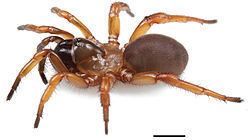Rank Genus | Order Spider | |
 | ||
Similar Myrmekiaphila neilyoungi, Eucteniza, Aptostichus, Wafer trapdoor spider, Euctenizidae | ||
Myrmekiaphila is a genus of trapdoor spiders in the family Euctenizidae. All described species are endemic to the southeastern United States. The genus was transferred from the Ctenizidae by Raven in 1985. M. flavipes was transferred from genus Aptostichus in 2007.
Contents
Myrmekiaphila or florida red trapdoor
Description
The known species of this genus resemble each other in appearance and behavior. The carapace is 2.8 to 8 mm long and 2.25 to 6.81 mm wide. Females are uniformly colored, with some dusky stripes on the dorsum of the abdomen. Colors range from yellowish red to dark reddish brown. The palpal tibia of the males are modified in a way that distinguishes them from other mygalomorph spiders of North America. The first legs in males are modified as mating claspers.
Biology
All members live in subterranean, silk-lined burrows that are covered by a silken-soil trap door. Some species construct side chambers that can be closed off by secondary trap doors, a feature that is unique among Cyrtaucheniidae. While the related Promyrmekiaphila and Aptostichus also build side chambers, they do not close them with trap doors.
Distribution
The genus is endemic to the southeastern United States, where it ranges from northern Virginia along the Appalachian Mountains southward through West Virginia, Kentucky, North and South Carolina, Tennessee and northern Georgia into the Southeastern Plain of Alabama, Mississippi and Florida.
They are found in a wide variety of habitats, including temperate deciduous forest in relatively high altitudes and dry climates in central Texas.
Systematics
The Euctenizinae were promoted from Cyrtaucheniidae subfamily to family in 2012.
Myrmekiaphila appears as the sister group to all southwestern Euctenizidae with the exception of Apomastus, which in turn is the sister group to all euctenizines.
Name
Genus describer Atkinson collected his specimens while hunting for ants, and found Myrmekiaphila always in close proximity to ant nests. Hence he gave the genus this name, derived from Ancient Greek myrmex "ant" and philein "to love", with the meaning "fond of ant nests".
Species
Three species groups are currently recognized. These are only intended to facilitate identification based on the male palp; it is not known if they represent monophyletic taxa. M. flavipes is only known from females and thus not grouped.
